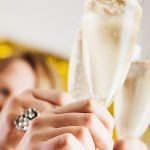
Champagne Dosage
Champagne dosage can vary the taste of the champagne dramatically.
Champagne dosage refers to the amount of sugar (or sweetening) dosage in the liqueur d’expedition*, which is a blend of sugar and wine added to the wine just before bottling.
While each house has a standard dosage for its different styles (non-vintage, vintage, cuvee de prestige, rosé, blanc de blancs, or blanc de noirs) they may also specifically make a wine that is extra dry or extra sweet.
A guide to champagne dosage
Brut Nature or zéro dosage – 0-2 grams per litre
- This is as dry as it gets.
- The first time you taste a zéro dosage you will remember it. Whether you like it or not, you will not be able to help but notice that dosage makes a difference to champagne.
- Zéro dosage champagnes have a distinct and quite intense chalkiness and minerality to them to the point that they are almost salty.
- This style won’t be to many people’s taste. I have found it hard to ever have more than one glass and this style can make a good palate cleanser between courses… just like a sorbet.
- These champagnes may also be called Sans-sucre, Brut Zero, Brut Integral, Ultra Brut, Brut Sauvage
If you want to try zero dosage style…
- You can’t go past trying the Louis Roederer Brut Nature … I enjoyed this more than any other I have tried. The minimalist philosophy and story behind the Philippe Stark collaboration (as told by Jean-Baptiste Lécaillon) is really rather magical and I swear it makes the champs taste better.
- Philoppannat Royale Reserve Non Dosé… I tried this wine at the house in Champagne but you may find it hard to get your hands on a bottle. The blend is 65% Pinot Noir, 30% Chardonnay, 5% Pinot Meunier. High pinot – so of course I like it! – which is a strong signature of the house, as is lower dosage particularly in all their vintage champagnes. The best word I can think of is…bold! Unadorned, perhaps quite primal.
Extra Brut: 0-6g/l
- Still quite dry so you will notice the chalk/ saltiness
- Again, Philoppannat vintage champagnes all sit in this dosage range
- Jacquesson’srange of champagnes all sit in this low dosage range
Brut: 0-12g/l
- Most champagnes you drink and enjoy will sit in this range, mostly within 8-11g/l
- In 2009, the Brut classification was lowered from 15 to 12g/l. Houses whose style sits on the dryer end of this spectrum are Piper Heidsieck, Louis Roederer, Charles Heidsieck… all around 11g/l. I couldn’t think of (or find) a brut champagne higher than this
Extra Dry: 12-20g/l
- There are several champagnes in this category but I can’t “recommend” one… because sweet champagnes are not my style so I don’t really enjoy them
- if you want to try one, give the Taittinger Nocturne a go. At 17g/l it is borderline sec champagne
Sec: 17-35g/l
- Try Taittinger Nocturne (at 17g/l) and Piper Heidsieck’s Cuvee Sublime (35g/l) which I included above but also fall into the Sec category.
Demi-sec: 33-50g/l
I haven’t tried any of these but if you like it sweet, options include:
- Pol Roger’s Rich Demi Sec (34g/l), Piper Heidsieck’s Cuvee Sublime (35g/l), Louis Roederer’s Carte Blanc is demi-sec (38g/l), Mumm’s demi-sec (40g/l), Laurent Perrier (40g/l), Canard Duchene offers a demi-sec (42g/l), and Moet and Chandon’s Moët Ice Impérial (45g/l) and Billacart Salmon demi-sec.
Doux: 50 + g/l
I haven’t tried the Veuve Cliquot Rich and Rich Rose which are both 60g/l !!!!!
*Liqueur d’expedition trivia
- The wine added with the sugar will be the same wine as in the bottle for vintages but for non-vintages it will be a selection of reserve wines
Make sure you post a pic and tag @bubbleandflute #Champagneschool to let me know you’re doing your homework and what you think!
Read more about different champagne styles
Blanc de Noirs champagne
Blanc De Blancs Champagne
Rosé Champagne
Vintage Champagne
Cuvée De Prestige Champagne
Non-Vintage (NV) Champagne
Champagne Styles… An Overview
Bubble & Flute promotes the responsible consumption of alcohol for individuals of legal drinking age in their country.















